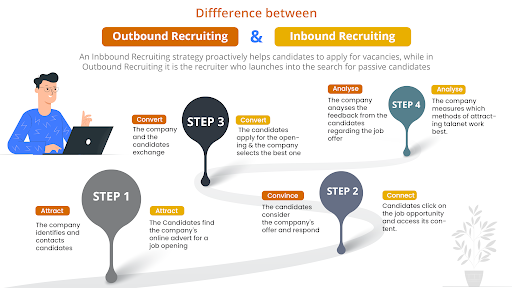Inbound vs Outbound Recruitment: What should you choose?
Published on August 9th, 2023
Recruitment is a critical aspect of any organization's growth and success. As businesses evolve, so do their recruitment strategies. Among the key decisions in designing an effective recruitment strategy is choosing between inbound and outbound recruitment approaches. Each approach has its own set of advantages and disadvantages, making the decision a pivotal one for any HR department. In this article, we delve into the intricacies of inbound and outbound recruitment to help you make an informed choice tailored to your organization's needs.
Understanding Inbound Recruitment
Inbound recruitment, also known as passive recruitment, involves creating an environment where top talent is naturally drawn to your organization. This approach places a strong emphasis on employer branding, employee testimonials, and an engaging online presence. The goal is to establish the company as an attractive destination for potential candidates. Inbound recruitment strategies include maintaining a well-designed career website, showcasing company culture on social media, and leveraging employee-generated content to give prospective hires an authentic glimpse into the organization.
Advantages of Inbound Recruitment
- Quality over Quantity: Inbound recruitment tends to attract candidates who are genuinely interested in the company's values, mission, and culture. This can result in a higher quality pool of applicants who are more likely to align with the organization's goals.
- Enhanced Employer Branding: By focusing on showcasing your organization's values and culture, you build a strong employer brand that can lead to increased employee retention and customer loyalty.
- Cost-Effectiveness: While establishing a strong inbound recruitment strategy may require an initial investment, the long-term benefits often outweigh the costs. You'll likely spend less on advertising and recruitment agencies over time.

Understanding Outbound Recruitment
Outbound recruitment, on the other hand, is the more traditional and proactive approach. It involves actively seeking out potential candidates through various means, such as job boards, recruitment agencies, and headhunting. Outbound recruitment is particularly useful when specific skill sets are required, and the organization needs to cast a wider net to find suitable candidates.
Advantages of Outbound Recruitment
- Targeted Skill Acquisition: Outbound recruitment allows organizations to seek out candidates with very specific skills or experiences that are essential for certain roles. This is especially crucial in industries with niche requirements.
- Faster Hiring Process: When time is of the essence, outbound recruitment can expedite the hiring process. Instead of waiting for interested candidates to apply, you actively approach potential candidates who already possess the desired qualifications.
- Wider Reach: Outbound recruitment helps you reach candidates who might not have been actively looking for new opportunities but could be interested in making a change if the right offer comes along.
Making the Right Choice
The decision to opt for inbound or outbound recruitment largely depends on your organization's goals, industry, and hiring needs. Often, a combination of both approaches can yield the best results. Here are a few considerations to guide your decision:
- Company Culture: If your company culture and values are strong differentiators, inbound recruitment might be more effective in attracting candidates who resonate with those aspects.
- Urgency: If you have urgent hiring needs, outbound recruitment can help you find suitable candidates quickly.
- Skill Specificity: For roles that demand highly specialized skills, outbound recruitment can help you target professionals with the exact qualifications you're seeking.
- Resource Allocation: Consider your budget and resource availability for both inbound and outbound recruitment strategies.
- Long-Term Vision: Inbound recruitment contributes to long-term employer branding and can result in a sustainable pipeline of inbound talent over time.
The Hybrid Approach
In reality, the line between inbound and outbound recruitment is not always clear-cut. Many successful organizations adopt a hybrid approach, leveraging the strengths of both methods. They build a strong employer brand to attract passive candidates while also actively seeking out top talent through outbound efforts when necessary. This comprehensive strategy allows companies to cover all bases and ensure a diverse pool of qualified candidates.
Conclusion
The choice between inbound and outbound recruitment is a nuanced decision that should be aligned with your organization's unique needs and goals. Inbound recruitment focuses on attracting candidates who align with your company's values, while outbound recruitment proactively seeks out individuals with specific skill sets. The most effective approach often involves a balance between both strategies, creating a holistic recruitment strategy that ensures a steady influx of quality talent. As the business landscape evolves, remaining flexible in your approach and open to adjustments will be key to staying competitive in the talent acquisition game.
About HireQuotient
HireQuotient stands at the forefront of HR-tech platforms, revolutionizing the hiring process itself. Through cutting-edge AI-driven technologies, HireQuotient revolutionizes recruitment by precisely connecting candidates with suitable roles. This empowers companies to make well-informed decisions grounded in data. The platform boasts an intuitive interface that prioritizes a personalized approach, thus enriching the candidate journey. Additionally, its extensive analytics toolkit equips businesses to refine their hiring strategies intelligently.
We specialize in offering skill-based assessments tailored for non-technical positions spanning diverse sectors. These assessments are meticulously crafted by subject matter experts and can be tailored to your needs. To expedite candidate discovery, we present an automated candidate sourcing tool that expedites the process, ensuring you find the right candidates promptly.
Book a demo now to know more.
Read More:
Authors

Radhika Sarraf
Radhika Sarraf is a content specialist and a woman of many passions who currently works at HireQuotient, a leading recruitment SaaS company. She is a versatile writer with experience in creating compelling articles, blogs, social media posts, and marketing collaterals.
Hire the best without stress
Ask us how
Never Miss The Updates
We cover all recruitment, talent analytics, L&D, DEI, pre-employment, candidate screening, and hiring tools. Join our force & subscribe now!
Stay On Top Of Everything In HR

